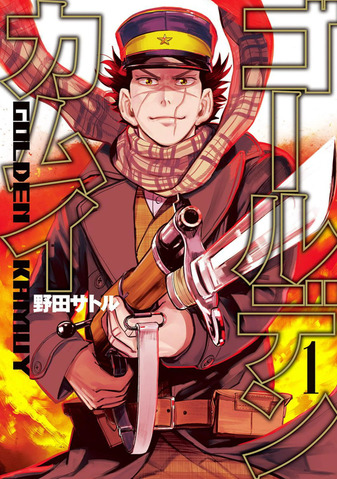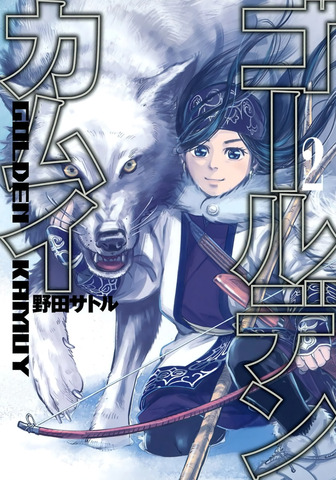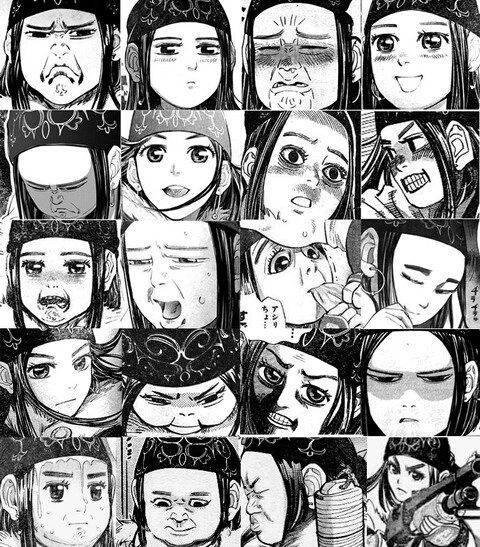#though I guess having 2 devourer of worlds surprise villains would feel repetitive
Explore tagged Tumblr posts
Text
My real Dawntrail hot take is I wish Sphene got to girlboss harder. I liked the sort of creepy vibe she had in the beginning, but they dropped it too fast to make the biggest slog of the game and we only got a hot second of "I AM THE DEVOURER OF WORLDS" which I suddenly I was into but we barely see it.
#dawntrailer spoilers#though I guess having 2 devourer of worlds surprise villains would feel repetitive#but being repetitive is like DTs favorite thing
2 notes
·
View notes
Text
to gold be the gory
How Golden Kamuy Outshines Competition
A Review

-
“GORUDEEEEEEN KAMUUUUUUY!”
That’s how I first heard of Golden Kamuy – a male voice screaming its title in around 2-minute intervals. I was busy slurping ramen in the communal eating tent in Odori Park when it blared in my ear. All through the day, they played its trailer on the tent TVs over and over again. It seemed interesting, and it was quite apt to see it being promoted there - after all, we were surrounded by snow, in Hokkaido, where the story was set. I kept seeing it in bookstores and its artwas eye-catching. But as soon as I was back on home soil, my interest was gone.
Life caught right back up with me, so I forgot about Golden Kamuy completely. Not until I saw some artists I follow post amazing fan art of it on Twitter. They were all singing it praises and the official art was beautiful, so I thought, ‘aw heck, why not?’
Let me tell you: there are no reasons not to.
SUGIMOTO, THIS ISN’T SHOUNEN ANYMORE
I’m what you call a…sporadic manga reader. I’m not up to speed with manga trends and it can take me a while to catch up. I read stuff that get my attention and when they’re recommended by my friends (I still haven’t touched Boku no Hero Academia or Shokugeki no Soma, though). I also don’t limit myself to just one genre. There are months that I devour shoujo/josei manga, like Hana Nochi Hare and Dame na Watashi ni Koi wo Kudasai. Then I’d switch over to read through volumes upon volumes of shounen manga (hi, Gintama, Haikyuu). Then there are periods wherein I just don’t read at all, devoting my time to other activities instead.
Golden Kamuy, brainchild of artist Noda Satoru, is probably my first real foray into the seinen manga territory. The art, the storyline, the comedy, the stakes – every page told me that I wasn’t reading shounen anymore. Dick jokes weren’t dealt with caution. Gore was done with no shame. Raw Japanese scans didn’t have the hiragana reading aids. Strangely enough, it brought me back to all the titles I used to read when I was young. It made me realize all the stuff I was reading back then were very edgelord-esque and middle-school-syndrome-ish - the stuff of nightmares. Body horror, violence, gore, debauchery – CLAMP and Kaori Yuuki had primed my teenage self for all of them.
But at least, now, the edginess was dealt with a more mature hand.
Hence it was no surprise that Kamuy ignited a sense of familiarity. I had mellowed down when I grew up (it saddens me that I really am quite a grown-up now) and, in turn, settled for fun, cheerful, romantic manga (to keep the dreariness of everyday life away, I guess haha). I got used to leisurely pacing and lighthearted comedy. Reading Golden Kamuy felt like I skydived into the unforgiving arena I had left – an arena that had been made fresher, better.
SO FRESH, YOU’RE EATING IT RAW
What makes Kamuy an instant hit is its interesting combination of rarely-used elements. Post-War, Meiji-Era historical, early 1900s, hunting, Hokkaido, Ainu culture: can you really find another title that uses said mix? It’s no wonder people are attracted to the series.
It also helps that the art is just spectacular. Noda’s artistic skill shines through every page, chapter, and volume cover. His poses are dynamic, his coloring brave. Sometimes the color combinations he uses just scream modern, serving as nice contrasts to the story’s historical, traditional setting. His character designs are unique and fresh – more so their personalities. Sugimoto’s facial scars are refreshing to the eye; Tsurumi’s half-corrupted face paired with a metal plate is a design I’ve never seen before. His art style brings out his designs to life in a way only he can – we’ve all seen cross-dressing men and shaved-bald convicts before, but still he was able to make Ienaga and Shiraishi look striking.
The research that he has done to make the story believable is commendable. He even has his own Ainu and Russian language consultants. Each detail he adds in shows that every page is a product of hard work. He even features real buildings in Hokkaido and Otaru (I’ve also been to Otaru and it was nice to see it in the manga!). The information we learn from Noda’s usage of the Ainu culture, hunting practices, and military details – all of this, weaved in with an intricate, explosive plot, give us a series that feels…whole. Complete.
Kamuy also spreads word about the Ainu culture in a fun and entertaining way. I haven’t heard a lot about them in the series I’ve encountered – I’ve only heard of them through Rurouni Kenshin. Nothing since then. To see them in the spotlight is a breath of fresh air. Even the Ainu themselves feel the same way – apparently they told Noda that they didn’t want to be portrayed as discriminated anymore. They wanted strong Ainu characters, and boy, did Noda deliver.
NO-PARDON PLOTTING
Because of its seinen status, you can tell that Noda has no qualms about plotting and story structure. We’re given heavy-hitting story elements right off the bat: war vet undertakes a legendary treasure hunt to help the (stolen-by-his-friend) love of his life, requiring him to track down 24 of the most dangerous insane criminals to have ever walked Japan. It’s throwing punches right from the get-go. Kamuy doesn’t baby anyone (except for bear cubs). With its pacing, convoluted plot and bevy of interesting characters, it challenges the reader to not just enjoy, but to keep up. It’s unapologetic in everything that it does – character, story, and art.
CHARACTERS
Immortal War Vet, Morality Pet Minority Action Girl, Escape Sweet-tooth King, and so forth. They somehow fulfill stereotypes but at the same time, Noda manages to twist things to a whole new light. His milieu, too, aids in solidifying the characters he writes – the setting itself makes them unforgettable.
It is also in his cast that we see how unapologetic Noda is. Considering that Sugimoto is to track 24 of the most dangerous criminals in the country, Noda doesn’t shy away from showcasing every kind of evil that can exist within humans. We tackle lust, greed, wrath, and avarice with a dash more reality compared to the caricatures we often see in shounen manga. Those faint of heart and innocent countenance will have a hard time stomaching Noda’s cast as it unfolds. The more I read, the more I believe Noda probably has a subscription to the Crime Investigation channel (which isn’t necessarily a bad thing). Truth be told, humans are very much capable of evil, and I’m not surprised that some of his villains are actually modeled after real-life criminals.
Notable characters:
IENAGA - a cross between Erszebet Bathory (a countess who was known to kill virgins and bathed in their blood to remain beautiful) and of H.H. Holmes, a real-life owner of an actual murder hotel in the US during the 19th century. Ienaga’s first dungeon appearance made me flashback to some of mangaka Kaori Yuki’s ornate gorefests such as Count Cain, Angel Sanctuary, and Ludwig Revolution. Noda felt no shame when he drew each and every one of Ienaga’s murderscapes.
HENMI KAZUO – this one really made me blink when I was reading it. Serial killer Henmi Kazuo is an exploration of the depths of human depravity. Imagine, being stimulated by gore and the act of clinging to life the same way his brother did when a bear ate him. Damn, writing that sentence made me realize Noda just straight up doesn’t baby his audience. This is the stuff Netflix series Mindhunter would kill to have. This also would really need some real guts (pardon the pun) to execute.
SHITON – he also made me stop in my tracks. Shiton, a full-on bestiality-practicing scientist, was something I’ve never read about in any other manga at all. I’ve read about murderers and criminals and incestuous personalities (Kaori Yuki and George RR Martin weren’t shy about it at all), but this character was just sick. He’s a special type of crazy (although to be perfectly honest I am sure that somewhere in the world some sick human is partaking in stuff like this), and for Noda to actually use him in his manga just takes courage. He just has the balls to make you think twice, but hey, when you’re in seinen territory, everything seems to be a free-for-all. And let’s be real frank here – there’s just another level of human debauchery in real life that most people won’t even be able to stomach hearing about.
TSURUMI – Tsurumi is the stuff of legend. He reminds me the most of Col. Hans Landa in Quentin Tarantino’s Inglorious Basterds, but with his insanity turned up into eleven. He also has shades of Leonardo’s character in Django Unchained, as well as other manic-type ‘villains’ that we’ve seen in other series. But his impulsiveness and flamboyant nature places him a cut above the rest. Noda also draws him so dynamically (seriously!) that whenever he appears, your eyes are just drawn to him.
Plus, I have to say that I’m really impressed with the level of real-world research that Noda uses in developing his characters. Tsurumi says that he has lost a part of his frontal lobe, which in turn affects his temper and his violent tendencies. This is actually true in real life, and has been seen in a high-profile murder case involving a famous football player in the United States. Because of the repetitive head injuries that the player received playing the sport, his own personality/temper had changed, and resulted him in killing his girlfriend in cold blood.
Of course we have the holy trinity of Sugimoto (classic lovable romantic badass war vet protagonist), Asirpa (butt-kicking girl-child) and Shiraishi (adorable slinky/comic relief), all gems in their own right. Noda has endeared them to us with the heartwarming dynamic between Sugimoto + Asirpa, plus Shiraishi’s antics. Character-wise, they seem to follow a specific trio formula that works in almost anything. Harry-Hermione-Ron, Gintoki-Kagura-Shinpachi, Naruto-Sakura-Sasuke. While his main character trio wins people over, his supporting cast can also shine bright on their own. Some great examples that come to mind are Ogata, Tanigaki, and Monkey-Scream Guy Otonoshin (even Tsukishima is memorable! He even has the Voldemort nose, doesn't he?).
Noda’s principle of mixing reality with caricature is also evident in his character designs. With every cast member we meet, it’s clear that Noda is far from being a sufferer of the six-faces-only syndrome. His designs do sometimes border on the impossible (Monkey-Scream guy’s eyebrows, really?), but it’s not a bad thing. If anything, it makes the visual experience of reading the comic even more worthwhile.
THE ART
Noda is a great manga artist. Let’s start with that.

Just look at these covers!

This coloring + color schemes!

This character design!!
I’ve been raving about his character designs for a few paragraphs now but it’s just really that good. I love his eye for composition and his impeccable framing for action and comedy. I’ve always thought that framing comics need special planning – especially action + comedy ones. You have to ensure that the first thing the reader sees in the next panel will make the action/joke understandable and clear. It takes great skill to decide what the reader sees and doesn’t see. Through Golden Kamuy’s 158 chapters, he makes use of this skill to make us laugh whenever Asirpa’s badgering them to make citatap, or when there’s a new animal part to eat, or when Tanigaki’s out showing nudes of himself to people. If the pages weren’t framed well, the jokes would’ve fallen flat. Let’s also not forget his adeptness in drawing facial expressions. This manga just does faces so well.

(Just look at Asirpa! collage c/o the Golden Kamuy reddit)
His fight scenes are also top-notch. You just know that Noda, as a mangaka, isn’t knocking about. The flow of action in every page is just downright superb. It also shows his mastery of human anatomy – and his courage when it comes to gore. His use of crisp blacks and whites, solid lineart, thick, expressive color give us pages that are fresh and clean...I’d be a fool to dismiss his technique, because his (and his studio’s, I guess?) skill just shines through every page.
He’s also not shy when it comes to details – which is admirable. After all, it takes some great dedication for someone to give his main character distinct facial scars that will require repeated drawings in almost every single page (and give his heroine a detailed headband). It makes me wonder just how he does it with a weekly schedule. His color pages look like they were done digitally, but I still have doubts whether or not he does his chapters by hand.
THE HEART
It took me just a few days to wolf down Kamuy. It was a romp right from the start – nail-biting, stomach-clutching, hair-raising. A truly entertaining piece, if you will. But if there’s one thing I’ve noticed with Kamuy, it’s that it somehow lacks heart.
Don’t get me wrong – it’s great! I love it. It’s superbly crafted, beautifully drawn, amazingly detailed. It’s one of the rare titles that I’m actually thinking of collecting. But it’s also a title that seems to drip technique. Like the author made it for the sake of drawing an intense, gripping title, but somehow solely for that purpose. It’s a career-conscious showcase of ability, a manufactured adventure in the truest sense. I couldn’t see the earnestness I found in Sorachi Hideaki’s Gintama, or the relatability of Nakahara Aya’s Dame na Watashi wo Koishite Kudasai. Full Metal Alchemist showed Arakawa Hiromu’s passion for muscled men, her interest in alchemy, and views on family, while Haruichi Furudate’s love for volleyball, sportsmanship and camaraderie is undeniable in Haikyuu!!. While I do like the backstory that Sugimoto is somehow based on his real-life war-vet grandfather, I find it a bit sad that it seems to lack that personal touch I’ve always liked seeing in other manga.
But it doesn’t mean that it’s not great. I will still recommend it to everyone I know. Awesome story, great art, refreshing comedy. By all means, read it! (Not sure about the anime, but I keep hearing reviews that we’re better off with the manga). Golden Kamuy is a title of both style and substance – whether it’s about the gore or the gold, I’m sure you won’t be disappointed.
Then let me know if you agree with my upcoming post, an analysis of Sugimoto and Asirpa.
Photos c/o reddit + our lovely scanlators + Satoru Noda
124 notes
·
View notes